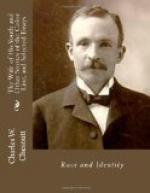The hope of the Negro, so far as the field of moral sympathy and support in his aspirations is concerned, lies, as always, chiefly in the North. There the forces which tend to his elevation are, in the main, allowed their natural operation. The exaggerated zeal with which the South is rushing to degrade the Negro is likely to result, as in the case of slavery, in making more friends for him at the North; and if the North shall not see fit to interfere forcibly with Southern legislation, it may at least feel disposed to emphasize, by its own liberality, its disapproval of Southern injustice and barbarity.
An interesting instance of the difference between the North and the South in regard to colored people, may be found in two cases which only last year came up for trial in two adjoining border States. A colored man living in Maryland went over to Washington and married a white woman. The marriage was legal in Washington. When they returned to their Maryland home they were arrested for the crime of “miscegenation”—perhaps it is only a misdemeanor in Maryland—and sentenced to fine and imprisonment, the penalty of extra-judicial death not extending so far North. The same month a couple, one white and one colored, were arrested in New Jersey for living in adultery. They were found guilty by the court, but punishment was withheld upon a promise that they would marry immediately; or, as some cynic would undoubtedly say, the punishment was commuted from imprisonment to matrimony.
The adding to our territories of large areas populated by dark races, some of them already liberally dowered with Negro blood, will enhance the relative importance of the non-Caucasian elements of the population, and largely increase the flow of dark blood toward the white race, until the time shall come when distinctions of color shall lose their importance, which will be but the prelude to a complete racial fusion.
The formation of this future American race is not a pressing problem. Because of the conditions under which it must take place, it is likely to be extremely slow—much slower, indeed, in our temperate climate and highly organized society, than in the American tropics and sub-tropics, where it is already well under way, if not a fait accompli. That it must come in the United States, sooner or later, seems to be a foregone conclusion, as the result of natural law—lex dura, sed tamen lex—a hard pill, but one which must be swallowed. There can manifestly be no such thing as a peaceful and progressive civilization in a nation divided by two warring races, and homogeneity of type, at least in externals, is a necessary condition of harmonious social progress.
If this, then, must come, the development and progress of all the constituent elements of the future American race is of the utmost importance as bearing upon the quality of the resultant type. The white race is still susceptible of some improvement; and if, in time, the more objectionable Negro traits are eliminated, and his better qualities correspondingly developed, his part in the future American race may well be an important and valuable one.




